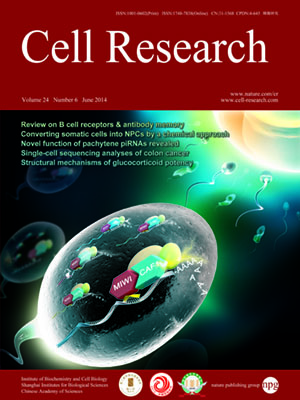
Volume 24, No 6, Jun 2014
ISSN: 1001-0602
EISSN: 1748-7838 2018
impact factor 17.848*
(Clarivate Analytics, 2019)
Volume 24 Issue 6, June 2014: 665-679 | Open Access
ORIGINAL ARTICLES
Generation of neural progenitor cells by chemical cocktails and hypoxia
Lin Cheng1,*, Wenxiang Hu1,*, Binlong Qiu1,*, Jian Zhao1,*, Yongchun Yu2, Wuqiang Guan2, Min Wang2, Wuzhou Yang2 and Gang Pei1,3
1State Key Laboratory of Cell Biology, Institute of Biochemistry and Cell Biology, Shanghai Institutes for Biological Sciences, Chinese Academy of Sciences, 320 Yueyang Road, Shanghai 200031, China
2Institute of Neurobiology, Institutes of Brain Science and State Key Laboratory of Medical Neurobiology, Fudan University, Shanghai 200032, China
3School of Life Science and Technology, Tongji University, Shanghai 200092, China
Correspondence: Gang Pei, E-mail: gpei@sibs.ac.cn; Jian Zhao,(jzhao@sibs.ac.cn)
Neural progenitor cells (NPCs) can be induced from somatic cells by defined factors. Here we report that NPCs can be generated from mouse embryonic fibroblasts by a chemical cocktail, namely VCR (V, VPA, an inhibitor of HDACs; C, CHIR99021, an inhibitor of GSK-3 kinases and R, Repsox, an inhibitor of TGF-β pathways), under a physiological hypoxic condition. These chemical-induced NPCs (ciNPCs) resemble mouse brain-derived NPCs regarding their proliferative and self-renewing abilities, gene expression profiles, and multipotency for different neuroectodermal lineages in vitro and in vivo. Further experiments reveal that alternative cocktails with inhibitors of histone deacetylation, glycogen synthase kinase, and TGF-β pathways show similar efficacies for ciNPC induction. Moreover, ciNPCs can also be induced from mouse tail-tip fibroblasts and human urinary cells with the same chemical cocktail VCR. Thus our study demonstrates that lineage-specific conversion of somatic cells to NPCs could be achieved by chemical cocktails without introducing exogenous factors.
10.1038/cr.2014.32
FULL TEXT | PDF
Browse 2509


